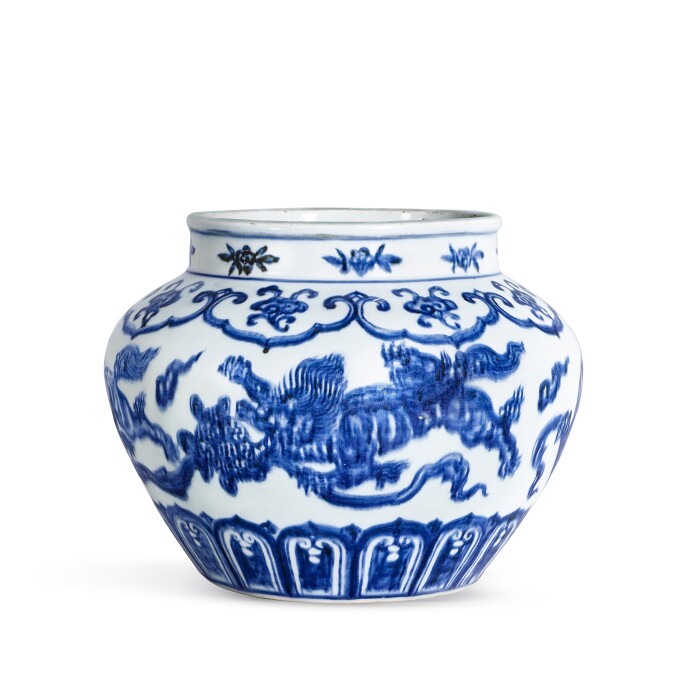F rom the imperial workshops in Jingdezhen, an exquisite blue-and-white jar made for the court of the Xuande Emperor (r. 1426-1435) is painted with boisterous animals, wildly chasing embroidered balls with fluttering ribbons. The design one of the most enchanting of the period, and there is hardly another motif that similarly challenges the painter’s ability to render movement. It was conceived in the Yongle period (1403-1424) and displays the playful ease with which Jingdezhen’s master painters wielded the brush in this peak period of blue-and-white creation. Rendered in soft, yet bold brush strokes in a vivid inky cobalt blue, it exemplifies China’s most admired and copied blue-and-white style.
Lions are not native to China. Although live animals were brought to the Chinese court by foreign embassies since at least the Han dynasty (206 BCE – 220 AD), they were always exotic rarities. In India, the lion is intimately associated with Buddhism, considered a symbol of strength and protector of the Dharma, the Buddhist law, and with the growing popularity of the Buddhist religion during the Tang dynasty (618-907), pairs of lion figures were increasingly placed in front of Buddhist temple gates as guardian animals.
The Yongle Emperor’s international diplomacy efforts brought China once more in direct contact with foreign lands, their animals, plants and other exotica in the early Ming dynasty (1368-1644). The court welcomed foreign embassies and the Muslim seafarer and diplomat, Court Eunuch Zheng He (c. 1371-1435), embarked on seven extensive maritime expeditions to ports throughout Asia and as far as Africa, which continued into the Xuande reign. At this time, lions were apparently so little known in China that Ma Huan (c. 1380-1460), Zheng He’s Muslim interpreter, who accompanied him on three of his voyages and left us a contemporary account, felt it necessary to describe them in detail:
“The lion has a body which resembles a tiger’s in shape; it is a dark-yellow colour, without stripes; it has a large head and a broad mouth; the tail tapers to a point, which has a lot of hair, black and long, like a tassel; the noise of its roar is like thunder. All the beasts, when they see it, fall down and dare not rise; it is indeed the king among the beasts.”
Although lions were among the exotic animals that had been brought to China already by some Timurid embassies, and on occasion were received as tribute by Zheng He’s delegation, they were rare and desirable enough to be specially purchased on these voyages, to be brought back to the court: during the sixth expedition in the Yongle reign, for example, when in 1421 the ships stopped in Aden, and during the seventh voyage in the Xuande reign, when in 1431 a division of the fleet went to Mecca, where it had, among other things, brought porcelain items as gifts.
It is highly unlikely that lions made it as far as Jingdezhen, but the animals’ wild chase of the embroidered spheres depicted on the present jar nevertheless looks as if observed from life, as lions indeed seem to enjoy playing with a ball. Designs appear to have been pre-drawn in the capital, which until 1420 was located not too far away in Nanjing. Judging by the fact that the exceedingly rare Yongle reign mark in blue-and-white was inscribed on a ball fought over by two lions inside a small cup in the Palace Museum, Beijing, we can assume that the lion motif enjoyed special imperial favour.

© Palace Museum, Beijing

© Shanghai Museum, Gift of Yao Nianyuan
During the Yongle and Xuande reigns, the kilns of Jingdezhen experienced unprecedented attention from the court, which practically took over the complete porcelain production and controlled all its aspects. This close supervision explains the superior composition of Yongle and Xuande blue-and-white designs, and the outstanding material which was vastly improved through controlled experimentation, testing, and rigorous quality control.
While much of the early Ming blue-and-white porcelain had been made to be sent abroad, pieces inscribed with the reign mark were almost invariably kept at the court. Guan jars are known to have been used as wine jars, and three covered jars of similar shape, probably made of gold and raised on red lacquer stands, can be seen in a handscroll entitled Amusements in the Xuande Emperor’s Palace placed on a table together with a golden wine ewer, a bottle, a covered bowl and a cup and stand.

Formerly in the collections of Mrs Walter Sedgwick, L.A. Basmadjieff, and Mr and Mrs Thomas Cole
Of the present design, only two companion pieces of Xuande mark and period appear to be recorded: a jar in the Shanghai Museum, and one from the collections of Mrs Walter Sedgwick, L.A. Basmadjieff, and Mr and Mrs Thomas Cole, which appeared five times in Sotheby's London rooms.
It is possible that the lion design on this jar also has Buddhist connotations, since very similar jars were also produced with another Buddhist motif, kui dragons with two lion’s paws and a long trailing tail. That motif is derived from the Indian makara, a guardian spirit similarly used as an architectural element to protect gateways, which equally had arrived in China from India with the introduction of Buddhism.

© The Fitzwilliam Museum, Cambridge (no. C.119 & A-1950) Michael Jones/The Fitzwilliam Museum, Image Li
The illustrious provenance of the present vessel can be traced back to England in the 1930s, its three previous owners all having been early members of the London Oriental Ceramic Society. For a closer look or to read more about the fascinating provenance of this piece, the full version of this article is available.



